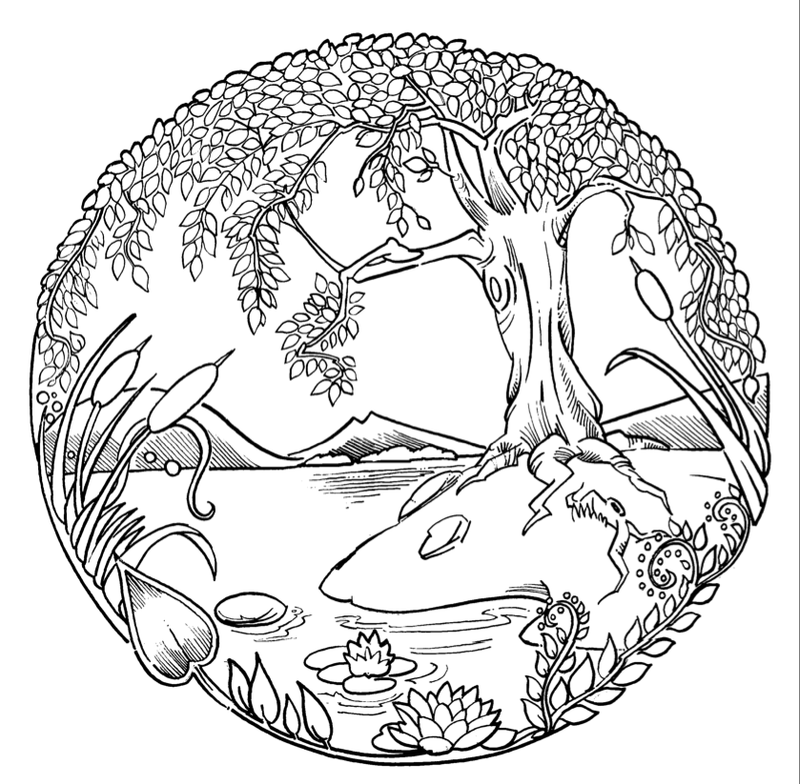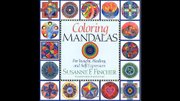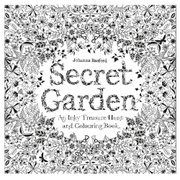We read books on our Kindles and newspapers on our iPads and we talk and text on smartphones. New gadgets make headline news and waiting lists for buying them are miles long. So, what kind of sign of the times is it that coloring books -- the kind that are used completely unplugged -- are topping the best-seller lists?
Coloring books for grown-ups, that is. These detailed sketches are not meant for little hands mastering fine motor skills. They are elaborate pieces of art beckoning for the careful application of hues and shades.
"Unwind after a long day," encourages Colorama, producer of the self-dubbed "coloring book that helps you relax."
"Immerse yourself in complex designs. Relax and color," advises Dover Publications.
Johanna Basford, the illustrator of Secret Garden: An Inky Treasure Hunt & Coloring Book (Laurence King Publishing, $15.95), which has sold about 1.5 million copies worldwide since it came out in 2013, told NPR's Audie Cornish recently that, "I think there's something quite charming and nostalgic about coloring in. And chances are last time you picked up pens or pencils you didn't have a mortgage or like a really horrible boss or anything."
Secret Garden was recently No. 5 on the Amazon.com best-seller list. The sequel, Enchanted Forest: An Inky Quest and Coloring Book (Laurence King Publishing, $15.95), is currently ranked No. 15.
It's impossible to know how many people in Arkansas or beyond are coloring between the lines of those or other books, because most people do it in the privacy of their homes. Many don't talk about it -- not because they're embarrassed, but because they don't do it for anyone else. It's something that brings them peace and joy.
But word about these books is getting out.
Karen Maxwell of Little Rock took her coloring book to her 11-year-old daughter's softball practice not long ago and several girls on the team peeked over the fence to get a closer look.
"They said, 'Are you coloring? Is that really a thing? Are you serious?'" Maxwell says.
She was, it is and yes, she assured them.
"No one has ridiculed, but people think of it as for kids and when they see I'm doing it, they look again," she says.
Her co-worker initially thought it was an odd pastime, but has since borrowed some coloring sheets and taken up the hobby.
Coloring mandalas, or "sacred circles," has long been used to promote inner focus and healing through meditation. Suzanne E. Fincher has crafted several mandala books, including several versions of Coloring
Mandalas (Shambhala, $18.95) and The Mandala Workbook (Shambhala, $22.95).
But the books that are all the rage are just as likely to be made up of complex scenes -- nature is a popular theme -- as circular patterns. Some even have storylines.
The Amazon.com synopsis of Secret Garden invites people to "tumble down the rabbit hole" and promises gardens "sheltering all kinds of tiny creatures just waiting to be found."
Adrienne Trafford's The Journey Coloring Book (Schiffer, $9.99) is created from The Journey Oracle, a deck of 46 tarot cards, and it bills itself this way: "Lovely women making decisions is the theme for this spiritual coloring book. It allows those coloring to reflect on the meanings of life's daily experiences as they color, and gives them a chance to think about their own choices ... Or just color for the fun of it!"
Lighthearted coloring books depicting everything from dinosaurs to 1990s fashion, holiday icons and more adult topics are also available, though some lean more toward humor than relaxation.
Maxwell, a teacher at an alternative learning environment school, first discovered that coloring helps center some of her students.
"Even the older kids, I've found since I came here, coloring calms them down," she says. "I started coloring with them a little bit sometimes if they were stressed out and I was trying to de-escalate a child from being angry or mad or upset. That's really how it started."
In her quest to help them, she stumbled upon coloring books that soothe her soul.
"Some of the kids didn't want, you know, the kiddie ones. And some of them wanted something a little bit more complex. I started out looking at some of the geometric ones," she says. "This last year I've found the coloring books that were more geared toward that type. I made coloring sheets for the kids for when they were upset and angry and then I started taking it home, and when I've had a stressful day I'll just sit there with my colors and my gel pens and color and just relax."
Pages colored by grown-ups are shared routinely on Instagram and Pinterest, as well as with friends through texts and social media. Maxwell sometimes sends pictures of her latest artwork to her friend Kathy Hall of Bryant, who stumbled into the world of coloring a couple of months ago.
The first picture she colored was a geometric pattern in a book she picked up at Sam's Club, and she used colored pencils.
Like many people, Hall appreciates the nostalgia-inducing scent of Crayola crayons. But so far, she prefers Fiskars gel pens, which are smoother and come with smells of their own.
" The purple pen I've been using smells like grapes," she says. "And gel pens come in metallic, bright, pastel ... I even have some gold and bronze and silver pens and some red and purple pens with little silver flecks in them. Gel pens have come a long way. And that's part of what makes it so much fun, is the variety."
Hall found ultimate satisfaction with a package of 72 gel pens.
"I like to have a light pink and a dark pink and so on, so that I can have that contrast because I find it difficult to color with a light hand and a heavy hand -- I want the pen to do the work for me," she says.
Jennifer Lewallen of Fort Smith, a veterinary assistant, prefers Crayola crayons to markers, and certainly to off-brand crayons.
"Those are really bad," she says of the knock-offs. "For me, just writing with a pencil -- it's a vibration on the paper or something and it changes with how hard you push down on the paper and whether it's dark or light. With a pen, it's just what it is, it's too flat and I want to be able to have some variations and variegated colors and that sort of thing."
She used to stock up on crayons every fall, when they were deeply discounted after the back-to-school rush, along with construction paper and other art supplies, to give as gifts at Christmas or Easter.
"And then I would ask kids, 'Hey, can I color with you?'" Lewallen says.
She doesn't have to do that anymore, having invested in her own coloring books.
"I have one that's those geometric shapes and designs and I have one that's butterflies and one that's mandalas," she says. "It's just the feel of the crayon on the paper and the rhythm ... I can focus on it and I don't have to think about anything else, except what color am I going to use here and how am I going to stay in the lines."
Sometimes she uses shades of gray, sometimes rainbow colors, depending on her mood.
"I'll open the box and pick a color," she says. "The butterfly ones -- those are fun because I'm playing with shading on colors and kind of blending them with the colors instead of just red or just blue -- you know, it's fun. I can look at it and go, 'You know, that's really pretty. I did a good job.'"
Lewallen relishes that feeling of accomplishment, especially in a world where it's not always clear when most jobs are completely done. But she leaves her pictures in the book when they're finished.
"I haven't put them on the refrigerator yet," she says, laughing.
Lewallen keeps coloring books upstairs in the room where her husband plays computer games and sometimes colors while he's busy.
"You just don't have to think about anything while you're coloring," she says. "It just shuts out the world."
Hall doesn't usually finish a whole picture at once. It might take her four or five days of coloring 15 or 20 minutes at a time to finish one sheet. Occasionally, though, she looks up and realizes she's lost herself in the art and an hour has gone by.
"What I do, my work, is very detailed and can be stressful," says Hall, a lawyer in private practice. "When I'm working and I need to take a break I can push my computer away and slide over a coloring book and I'll just start coloring. It relaxes my mind because I'm paying attention to a different kind of detail, because I'm thinking about what color I want to use next and I can see my progress as I go."
While there is a definite right and wrong way to do her job, nothing dictates how Hall colors her pictures.
"The beauty of coloring is that, like if you go back to when you were 5 years old, there's no wrong way to color a picture. I can't mess that up," she says.
Hall finds herself concentrating on keeping color patterns in order and symmetrical, and reminds herself to let go of worry about adhering to a consistent color pattern. Worry is something she colors to forget, after all.
"The next one I do, I want to not feel so restricted. It does not have to match. It does not have to all be so uniform. But it's so hard," she says. "It's a good creative outlet and it's relaxing and it's soothing and you end up with something beautiful when you're done. And you don't have to be an artist. All you have to do is stay in the lines -- and you don't even have to do that if you don't want to."
Family on 06/24/2015
READ MORE
- http://www.arkansas…">Color yourself a contest winner


